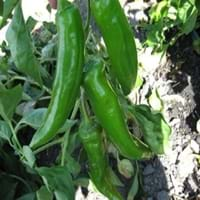Life Span
Annual and Perennial
Perennial
Type
Bulb or Corm or Tuber
Vegetable
Origin
Central America, South America
Mexico, Central America, South America
Types
Vine, Flowering plant
Ancho chili
Number of Varieties
Not Available
Habitat
All sorts of environments, Along Railroads, Banks, Moist Ditches, Roadsides, rocky banks of streams
Fertile bottom land
USDA Hardiness Zone
10-13
5-12
Sunset Zone
21,22
A1, A2, A3, H1, H2, 1a, 1b, 2a, 2b, 3a, 3b, 4, 5, 6, 7, 8, 9, 10, 11, 12, 13, 14, 15, 16, 17, 18, 19, 20, 21, 22, 23, 24
Habit
Vining/Climbing
Upright/Erect
Minimum Width
Not Available
Flower Color
Purple, Rose
White, Green, Ivory
Flower Color Modifier
Bicolor
Bicolor
Fruit Color
Not Available
Red, Green, Orange Red
Leaf Color in Spring
Purple, Dark Green, Black
Green
Leaf Color in Summer
Light Green
Green
Leaf Color in Fall
Several shades of Green
Green, Black
Leaf Color in Winter
Light Green
Not Available
Leaf Shape
Acicular
Ovate
Plant Season
Spring, Summer, Fall, Winter
Summer, Fall
Sunlight
Full Sun, Partial Sun
Full Sun
Growth Rate
Very Fast
Medium
Type of Soil
Clay, Loam, Sand
Loam
The pH of Soil
Acidic, Neutral, Alkaline
Neutral
Soil Drainage
Well drained
Well drained
Bloom Time
Late Spring, Early Summer, Summer, Late Summer, Early Fall, Fall, Late Fall
Late Spring, Early Summer, Summer, Late Summer, Indeterminate
Tolerances
Drought
Drought
Where to Plant?
Container, Ground
Container, Ground, Pot
How to Plant?
Cuttings, Leaf Cutting, Tuber propagation
Seedlings
Plant Maintenance
Medium
Medium
Watering Requirements
Keep the Soil well drained, Needs very little water
Average Water Needs, Do Not over Water, Requires regular watering
In Summer
Lots of watering
Lots of watering
In Spring
Moderate
Moderate
In Winter
Average Water
Average Water
Soil pH
Acidic, Neutral, Alkaline
Neutral
Soil Type
Clay, Loam, Sand
Loam
Soil Drainage Capacity
Well drained
Well drained
Sun Exposure
Full Sun, Partial Sun
Full Sun
Pruning
Remove damaged leaves, Remove dead branches, Remove dead leaves
Remove damaged leaves, Remove dead branches, Remove dead leaves, Remove dead or diseased plant parts, Remove deadheads
Fertilizers
All-Purpose Liquid Fertilizer
5-10-10 fertilizer
Pests and Diseases
Red blotch
Red blotch
Plant Tolerance
Drought
Drought
Flower Petal Number
Single
Single
Foliage Texture
Coarse
Medium
Foliage Sheen
Matte
Glossy
Attracts
Aphids, Beetles, Cutworms, Insects, Mites, Whiteflies
Aphids
Allergy
Abdominal pain, allergic reaction, Nausea, Skin rash, Twitching of face
Constipation, Diarrhea, Headache, Hives, Itchiness, Low blood pressure, Nausea, Runny nose, Sore eyes, Sore Throat, Swelling in the face, Swollen Lips, Vomiting
Aesthetic Uses
Not Used For Aesthetic Purpose
Not Used For Aesthetic Purpose
Beauty Benefits
Not Available
Not Available
Environmental Uses
Air purification
Air purification
Medicinal Uses
Cures constipation, Fiber, Low calories, lowering blood pressure, Potassium, ß-carotene, Vitamin A, Vitamin C
Not Available
Part of Plant Used
Leaves, Root, Shoots, Stem, Tuber
Fruits, Seeds
Other Uses
Starch, Used As Food, Used as Ornamental plant
Used As Food
Used As Indoor Plant
Sometimes
Yes
Used As Outdoor Plant
Yes
Yes
Garden Design
Container, Edible, Groundcover, Hanging Basket, Herb / Vegetable, Mixed Border, Rock Garden / Wall, Vine
Bedding Plant, Container, Edible, Herb / Vegetable, Mixed Border, Tropical
Botanical Name
IPOMOEA batatas 'Blackie'
CAPSICUM annuum 'Anaheim'( Longum Group)
Common Name
Blackie Sweet Potato Vine, Sweet Potato Vine
Anaheim Chile, Hot Pepper
In Hindi
शकरकन्द
Anaheim Chile Plant
In German
Süßkartoffel
Anaheim Chile Pflanze
In French
Patate douce
Anaheim Chili Plante
In Spanish
Ipomoea batatas
Planta de Chile Anaheim
In Greek
Sweet potato
Anaheim Χιλή Φυτών
In Portuguese
Batata-doce
Anaheim Chile Planta
In Polish
Wilec ziemniaczany
Anaheim Chile roślin
In Latin
Ipomoea batatas
Planta Anaheim Chile
Phylum
Tracheophyta
Magnoliophyta
Class
Magnoliopsida
Magnoliopsida
Order
Solanales
Solanales
Family
Convolvulaceae
Solanaceae
Clade
Angiosperms, Asterids, Eudicots
Asterids, Eudicots
Tribe
Not Available
Not Available
Subfamily
Not Available
Not Available
Number of Species
Not Available
Not Available
Season and Care of Sweet Potato Vine and Anaheim Chili
Season and care of Sweet Potato Vine and Anaheim Chili is important to know. While considering everything about Sweet Potato Vine and Anaheim Chili Care, growing season is an essential factor. Sweet Potato Vine season is Spring, Summer, Fall and Winter and Anaheim Chili season is Spring, Summer, Fall and Winter. The type of soil for Sweet Potato Vine is Clay, Loam, Sand and for Anaheim Chili is Loam while the PH of soil for Sweet Potato Vine is Acidic, Neutral, Alkaline and for Anaheim Chili is Neutral.
Sweet Potato Vine and Anaheim Chili Physical Information
Sweet Potato Vine and Anaheim Chili physical information is very important for comparison. Sweet Potato Vine height is 15.00 cm and width Not Available whereas Anaheim Chili height is 45.70 cm and width 38.10 cm. The color specification of Sweet Potato Vine and Anaheim Chili are as follows:
Sweet Potato Vine flower color: Purple and Rose
Sweet Potato Vine leaf color: Purple, Dark Green and Black
Anaheim Chili flower color: White, Green and Ivory
- Anaheim Chili leaf color: Green
Care of Sweet Potato Vine and Anaheim Chili
Care of Sweet Potato Vine and Anaheim Chili include pruning, fertilizers, watering etc. Sweet Potato Vine pruning is done Remove damaged leaves, Remove dead branches and Remove dead leaves and Anaheim Chili pruning is done Remove damaged leaves, Remove dead branches, Remove dead leaves, Remove dead or diseased plant parts and Remove deadheads. In summer Sweet Potato Vine needs Lots of watering and in winter, it needs Average Water. Whereas, in summer Anaheim Chili needs Lots of watering and in winter, it needs Average Water.





